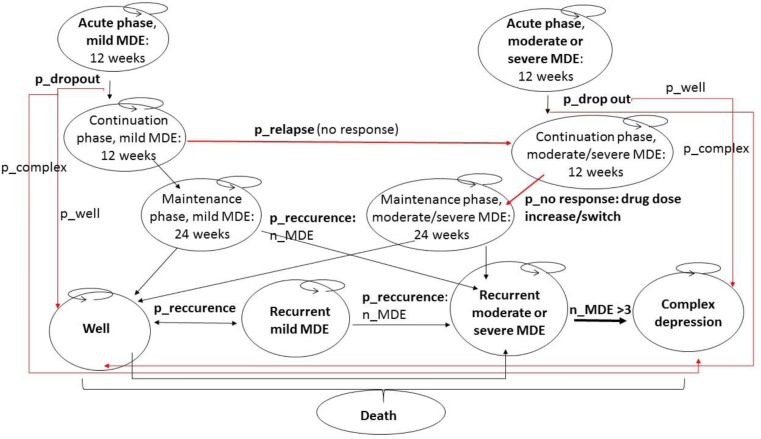Figure 3: Model Structure.
Abbreviation: MDE, major depressive episode.
This figure depicts an individual-level (microsimulation) Markov model that includes 11 health states, each represented by an oval, reflecting the course of mild or moderate to severe major depressive disorder. The simulation starts with a hypothetical patient aged between 18 and 75 years (age is drawn from a distribution) with a first mild or moderate to severe major depressive episode. In each 1-week cycle, a patient has a chance to move among health states. Death is an absorbing Markov health state. The model accounts for the age of major depressive disorder onset, counts the number of recurrent events, and modifies the risk of future major depressive episodes and changes in treatment accordingly. It takes into account the probability of death as a result of suicide according to the severity of disease and the probability of hospitalization in the complex depression health state. Transfer to the complex depression health state depends on the number of prior major depressive episodes (n ≥ 3). “p_dropout” denotes the probability of dropping out in the acute-phase states for patients with either a mild or moderate to severe major depressive episode; “p_well” and “p_complex” denote the probabilities of transferring to the well or complex depression health states, respectively, after dropping out in the acute phase; “p_relapse” denotes the probability of relapse and is related to a change in health state (e.g., from mild to moderate major depressive disorder) and change in treatment; “p_no response” in the maintenance phase for a patient with moderate or severe major depressive disorder triggers an increase in dose of antidepressant or a switch from sertraline to venlafaxine; “p_recurrence” denotes the probability of recurrence modelled in different health states, with “n_MDE” denoting a tracker variable that counts a number of recurrent major depressive episodes.

